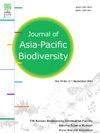菝葜(sapinaceae)叶绿体全基因组序列及系统发育定位
IF 0.7
Q4 BIODIVERSITY CONSERVATION
引用次数: 0
摘要
七叶菊(七叶菊科)是一种具有重要药用价值的植物。本研究获得了turbinata Aesculus的叶绿体全基因组序列,全长156,251 bp。它包括一个85,981 bp的大单拷贝区,一个18,854 bp的小单拷贝区和两个反向重复区(每个25,708 bp)。叶绿体基因组共包含130个基因,其中蛋白质编码基因85个,转移rna 37个,核糖体rna 8个,鸟嘌呤和胞嘧啶含量为38.07%。12个基因含有内含子:11个基因含有一个内含子,而pafI只含有两个内含子。rps12基因反式剪接成三个外显子。倒置重复区复制8个蛋白质编码基因、2个转移rna和4个核糖体rna。基于Sapindaceae全叶绿体基因组的系统发育分析有力地支持了七叶树(Aesculus turbinata)和七叶树(Aesculus hippocastanum)之间的密切关系,为该科的进化分类学提供了重要的见解。本文章由计算机程序翻译,如有差异,请以英文原文为准。
The complete chloroplast genome sequence and phylogenetic position of Aesculus turbinata Blume (Sapindaceae)
Aesculus turbinata Blume (Sapindaceae) is a medicinally significant species. This study presents the complete chloroplast genome sequence of Aesculus turbinata, which spans 156,251 bp. It includes a large single-copy region of 85,981 bp, a small single-copy region of 18,854 bp, and two inverted repeat (25,708 bp each) regions. The chloroplast genome contains a total of 130 genes, consisting of 85 protein-encoding genes, 37 transfer RNAs, and 8 ribosomal RNAs, with a guanine and cytosine content of 38.07%. Twelve genes contain introns: 11 possess a single intron, while pafI uniquely harbors two. The rps12 gene is trans-spliced into three exons. The inverted repeat regions duplicate eight protein-coding genes, two transfer RNAs, and four ribosomal RNAs. Phylogenetic analysis based on complete chloroplast genomes of Sapindaceae strongly supports the close relationship between Aesculus turbinata and Aesculus hippocastanum, providing critical insights into the evolutionary taxonomy of this family.
求助全文
通过发布文献求助,成功后即可免费获取论文全文。
去求助
来源期刊

Journal of Asia-Pacific Biodiversity
Agricultural and Biological Sciences-Insect Science
CiteScore
1.70
自引率
12.50%
发文量
94
审稿时长
27 days
期刊介绍:
The Journal of Asia-Pacific Biodiversity (previous title was Journal of Korean Nature) is an official journal of National Science Museum of Korea (NSMK) and Korea National Arboretum (KNA). The scope of journal is wide and multidisciplinary that publishes original research papers, review articles, as well as conceptual, technical and methodological papers on all aspects of biological diversity-its description, analysis and conservation, and its application by humankind. This wide and multidisciplinary journal aims to provide both scientists and practitioners in conservation theory, policy and management with comprehensive and applicable information. However, papers should not be submitted that deal with microorganisms, except in invited paper. Articles that are focused on the social and economical aspects of biodiversity will be normally not accepted.
 求助内容:
求助内容: 应助结果提醒方式:
应助结果提醒方式:


